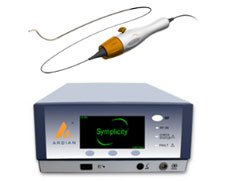
Categorised under:
Interventional Radiology
>
Vascular
>
Renal denervation
Renal denervation is a novel catheter based approach that has been shown to effectively lower blood pressure in patients with resistant hypertension. Small studies have shown additional benefits in patients being treated for hypertension, such as improvements in insulin sensitivity, sleep apnoea and arrhythmias
Credits: PubMed, Minerva Cardioangiol. 2013 Jun;61(3):271-80.
Resistant hypertension remains a major clinical problem despite the available multidrug therapy. Over the next decades, its incidence will likely increase given that it is strongly associated with older age and obesity. Resistant hypertension patients have an increased cardiovascular risk, thus effective antihypertensive treatment will provide substantial health benefits
Credits: PubMed, http://www.ncbi.nlm.nih.gov/pubmed/23675555
The Symplicity HTN-2 trial has shown that RSD reduces blood pressure to a clinically relevant degree; this finding has resulted in an explosion in interest in the procedure and RSD has the potential to become a standard therapy for many hypertensive patients
Credits: PubMed, Expert Rev Med Devices. 2013 May;10(3):329-38.
Percutaneous sympathetic denervation could prove to be an effective mini-invasive strategy for the treatment of chronic renal pain, and LPHS in particular.
Credits: PubMed, Nephrol Dial Transplant. 2013 May 7. [Epub ahead of print]
From Dr WRight, St Josephs medical centre
Credits: SlideShare
We enrolled 50 patients at five Australian and European centres; 5 patients were excluded for anatomical reasons (mainly on the basis of dual renal artery systems). Patients received percutaneous radiofrequency catheter-based treatment between June, 2007, and November, 2008, with subsequent follow-up to 1 year. We assessed the effectiveness of renal sympathetic denervation with renal noradrenaline spillover in a subgroup of patients. Primary endpoints were office blood pressure and safety data before and at 1, 3, 6, 9, and 12 months after procedure. Renal angiography was done before, immediately after, and 14-30 days after procedure, and magnetic resonance angiogram 6 months after procedure. We assessed blood-pressure lowering effectiveness by repeated measures ANOVA. This study is registered in Australia and Europe with ClinicalTrials.gov, numbers NCT 00483808 and NCT 00664638.
Credits: Lancet. 2009 Apr 11;373(9671):1275-81
Renal sympathetic hyperactivity is seminal in the maintenance and progression of hypertension. Catheter-based renal sympathetic denervation has been shown to significantly reduce blood pressure (BP) in patients with hypertension. Durability of effect beyond 1 year using this novel technique has never been reported
Credits: Hypertension. 2011 May;57(5):911-7
Renal sympathetic nerve activation contributes to the pathogenesis of hypertension. Symplicity HTN-2, a multicenter, randomized trial, demonstrated that catheter-based renal denervation produced significant blood pressure lowering in treatment-resistant patients at 6 months after the procedure compared with control, medication-only patients. Longer-term follow-up, including 6-month crossover results, is now presented.
Credits: Circulation. 2012 Dec 18;126(25):2976-82
Denervating the human kidney to improve blood pressure control is an old therapeutic concept first applied on a larger scale by surgeons in the 1920s. With the advent of modern pharmacology and the development of powerful drugs to lower blood pressure, approaches to directly target the sympathetic nerves were more or less abandoned. Over the past 2-3 years, however, we have witnessed enormous renewed interest in novel and minimally invasive device-based approaches to specifically target the renal nerves.
Credits: Curr Hypertens Rep. 2012 Jun;14(3):247-53
In this multicentre, prospective, randomised trial, patients who had a baseline systolic blood pressure of 160 mmHg or more (>=150 mmHg for patients with type 2 diabetes), despite taking three or more antihypertensive drugs, were randomly allocated in a one-to-one ratio to undergo renal denervation with previous treatment or to maintain previous treatment alone (control group) at 24 participating centres. Randomisation was done with sealed envelopes. Data analysers were not masked to treatment assignment. The primary effectiveness endpoint was change in seated office-based measurement of systolic blood pressure at 6 months. Primary analysis included all patients remaining in follow-up at 6 months. This trial is registered with ClinicalTrials.gov, number NCT00888433.
Credits: Lancet. 2010 Dec 4;376(9756):1903-9

Did you know you can Register for FREE with this website?
Registration gives you full access to all of the features of WhichMedicalDevice. Find out more ...
WhichMedicalDevice is a FREE resource created by clinicians for clinicians.
Registration is free and gives you unlimited access to all of the content and features of this website.
Find out more...Registration is free and gives you unlimited access to all of the content and features of Which Medical Device. Find out more...
Which Medical Device is a community of clinicians sharing knowledge and experience of the devices and procedures we use on a daily basis. We ask that our members register with us so that we can maintain the unbiased and independent nature of our content. Registration is quick and free.
We do not make your details available to any third parties nor do we send unsolicited emails to our members. You can read our Privacy Policy here.